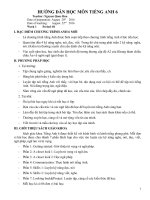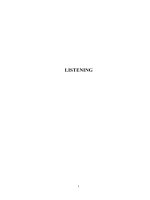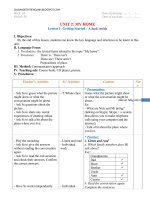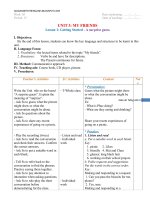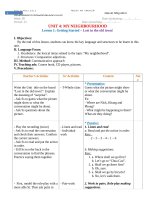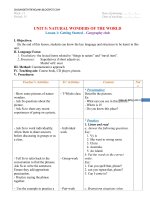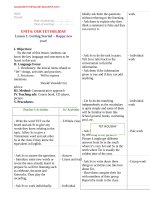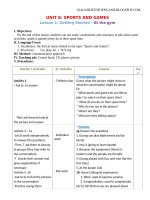Tiếng anh 6 (sách mới) giáo án cả năm xuân đỗ thị
Bạn đang xem bản rút gọn của tài liệu. Xem và tải ngay bản đầy đủ của tài liệu tại đây (1.03 MB, 170 trang )
HƯỚNG DẪN HỌC MÔN TIẾNG ANH 6
Teacher: Nguyen Quoc Hoa
Date of preparation: August 20th 2016
Date of teaching: August 22nd 2016
Week 1
Period :01
I. ĐẶC ĐIỂM CHƯƠNG TRÌNH ANH 6 MỚI
-
Là chương trình tiếng Anh được biên soạn tiếp theo chương trình tiếng Anh ở bậc tiểu học.
-
Quan tâm đến 4 kỹ năng nghe, nói, đọc, viết. Trong đó chú trọng phát triển 2 kỹ năng: nghe,
nói. (Kiểm tra thường xuyên chủ yếu dành cho kỹ năng nói).
-
Vào cuối năm học, học sinh cần đạt trình độ tương đương cấp độ A2 của Khung tham chiếu
châu Âu về ngôn ngữ (giai đoạn 1).
II. PHƯƠNG PHÁP HỌC
1. Tại trường:
-
Tập chung nghe giảng, nghiêm túc làm theo các yêu cầu của thầy, cô.
-
Hăng hái phát biểu ý kiến xây dựng bài.
-
Luyện tập nói tiếng Anh với thầy, với bạn bè, tận dụng mọi cơ hội có thể để tập nói tiếng
Anh. Nói đúng trọng âm, ngữ điệu.
-
Nắm vững các vấn đề ngữ pháp đã học, các cấu trúc câu. Ghi chép đầy đủ, chính xác.
2. Tại nhà:
-
Ơn lại bài học ngay khi có tiết học ở lớp.
-
Dựa vào các cấu trúc và các ngữ liệu đã học để luyện nói tiếng Anh cùng bạn.
-
Làm đầy đủ bài tập trong sách bài tập. Tìm đọc thêm các loại sách tham khảo nếu có thể.
-
Thường xuyên học, củng cố và mở rộng vốn từ của mình.
-
Viết từ mới và mẫu câu hay vào sổ tay học tập của mình.
III. GIỚI THIỆU SÁCH GIÁO KHOA
Sách giáo khoa Tiếng Anh 6 được thiết kế với kênh hình và kênh tiếng phong phú. Mỗi đơn
vị bài học được chia thành 7 phần thích hợp cho việc rèn luyện các kỹ năng nghe, nói, đọc, viết,
ngữ pháp, ngữ âm và từ vựng.
-
Phần 1: Getting started: Giới thiệu từ vựng và ngữ pháp.
-
Phần 2: A closer look 1: Luyện từ vựng và ngữ âm.
-
Phần 3: A closer look 2: Học ngữ pháp
-
Phần 4: Communication: Thực hành nói tiếng Anh.
-
Phần 5: Skills 1: Luyện kỹ năng đọc, nói
-
Phần 6: Skills 2: Luyện kỹ năng viết, nghe.
-
Phần 7: Looking back&Project: Luyện tập, củng cố các kiến thức đã học.
-
Mỗi học kì có 06 đơn vị bài học.
1
IV. CHUẨN BỊ:
- Sách học sinh, sách bài tập.
- Chuẩn bị phần: Unit 1: Getting started cho tiiets học sau.
....................................................................................
UNIT 1: MY NEW SCHOOL
Getting Started: A Special Day
Teacher: Nguyen Quoc Hoa
Date of preparation: August 20th 2016
Date of teaching: August 23rd 2016
Week 1
Period :02
I. Objectives:
By the end of the lesson, the sts can use the lexical items related to the topic: “My new
school”
II. Language contents:
-Vocabulary :
school things and activities
-Pronunciation : sounds / / and / /
-Grammar : The present simple & The present continuous verb (study, have, do, play)
-Communication : + Talking about and describing a school
+ Talking about and describing school activities
III. Teaching method: Communicative teaching method
IV. Teaching aids: Textbook, picture, tape.
V. Procedures:
Teacher’s and students’activities
1. Lead-in:
T asks Ss Qs about the picture:
Pre- pracice
Teaches new words:
-T shows the school objects
- Ss guess the meaning
-Ss listen and repeat
-Ss copy down
-T checks the students’ understanding of new words
by using “Slap The Board” game
2.Controlled-Practice
-T plays the recoding
Ss listen and read
-Ss work independently.
T has Ss to share their As and then explain their ideas
with the class.
Contents
Ex: -What is Phong doing?
-Who are Vy and Duy?
-Why is it a special day?
New words:
notebook (n) :
calculator (n) :
uniform (n) :
1.Listen and read.
a. Are these sentences true (T) or
false (F)
-T tell Ss refer back to the coversation to finf the Key: 1.T 2.T 3.F 4.T 5.F
expressions.
Ss practice saying them together.
-T explain the meaning (or give SYN) to the Ss, then b. Find these expressipns in the
2
give some examples.
-T asks Ss to role-play the short coversations in pairs
before creating short role-plays
More able Ss can try to extend the conversation.
-T plays the recording.
The whole class read the poem with the right
intonation and rhythm.
-T asks some Qs to check Ss’understanding of the
poem.
-Ss work in pairs and write the poem about their
partner, then read the poem aloud.
-T has Ss to match the words with the school things.
-T plays the recording
Ss listen and repeat then practice saying the the names
of the school things.
-T explains the meaning (using visual aids)
-Ss cheks their answer in pairs
3.Free- Practice
-T tells Ss to look around the class . Ask what they
have (point to each st): table, desk, board, picture,…
Ss practise the words, and make up sentences with the
words
-T has Ss draw pictures next to new words in their
vocabulary book
-Ss can give SYN or explainations, or write
Vietnamese equivalent.
Ss do the exercises B123.
4. Homework:
- Learn vocabulary by heart.
- Prepare next lesson
(A closer look 1)
conversation. Check what they
mean.
Key:
1.used to express surprise (negative)
2.”you’ll find out”
3.used to invite sb in
4.used to say “yes”/ “alright”
c.Work in pairs. Create short roleplays with these expressions. Then
practice them
Ex: -Will you open the door?
- Sure
2.Listen and read the following
poem:
Ex:
Khanh is going back to school today.
His friends are going back to school,
too.
His new school year starts today.
He’s got a nice school bag.
He’s got a new bike.
His frieds are on their way .
…
3. Match the words with the school
things.
Key:
1.b 2.e 3.j 4.d
7.f 8.a 9.g 10.h
5.c
6.i
4.Look around the class –What other
things do you have in classroom?
Ask your teacher.
*Learning tip:
……………………………..
UNIT 1: MY NEW SCHOOL
A Closer Look 1
Teacher: Nguyen Quoc Hoa
Date of preparation: August 20th 2016
Date of teaching: August 24th 2016
Week 1
Period :0
I.Objectives:
3
By the end of the lesson, the sts can:
-Pronounce correctly the sounds / / and / / in isolation and in context.
-Use the combinations: to study, to have, to do, to play + noun
II. Language contents:
-Vocabulary:
school subjects and school activities
-Pronunciation: sounds / / and / /
-Grammar: The present simple & The present continuous verb (study, have, do, play)
-Communication: + Talking about and describing a school
+ Talking about and describing school activities
III. Teaching methods: Repetition, using pictures, pair/ groupwork, explanation, question-answer.
IV. Teaching aids: Textbook, picture, tape.
V. Procedures:
Teacher’s and students’activities
Contents
1. Lead-in:
T asks Ss Qs about the subjects:
Ex. -What is your favourite subject?
-What subject is difficult/ easy?
Pre- pracice
Teaches new words:
-T shows the school subjects
-Ss listen and repeat
-Ss copy down
-T checks the students’ understanding of new words
by using “Slap The Board”
2. Controlled-Practice
-T plays the recoding
Ss listen and repeat
-T corrects Ss’pronounciation
-T lets Ss work in pairs, putting the words into groups.
T explains them which words go with each verb
New words:
judo (n)
excercises (n)
homework (n)
lessons (n)
vocabulary (n)
school lunch (n)
VOCABULARY
1. Listen and repeat the words
2.Work in pairs. Put the words into
groups
4
Key:
-T tells Ss to do the task individially.
Calls some Ss to write on the board, then check their
As
-T asks Ss to write sentences about themselves in their
notebooks, using the combination above.
Ss can write as many sentences as possible
-T lets Ss play the sounds together.
Asks Ss to observe T’s lip positions for these two
sounds.
-T plays the recording
Ss listen and repeat
-T plays the recording twice.
Ss work individially then check their As in groups.
-T calls some Ss to write the As on the BB
-T the recording.
Ss repeat sentence by sentence.
-T helps Ss to recognize the two sounds, then
underline them in the sentences
3. Free- Practice
-T has Ss to find out more words that have the two
sounds
Ss read the words aloud
-Ss retell the school subjects and activities and the two
sounds
Ss do the exercises A1, 2, B56
4. Homework:
- Learn vocabulary by heart.
- Prepare next lesson
(A closer look 2)
Play
Football
music
Have
School lunch
lessons
Do
Homework
Judo
exercises
Study
Physics
English
History
Vocabulary
science
3. Put one of these words in each
blank
Key:
1.homework 2.football
.4.judo 5.science
3.lessons
4. Write sentences about yourself
using the combination above
Ex.
I/We have English lessons on Tuesday
and Thursday
……
PRONOUNCIATION
5.Listen and repeat.
Pay attention to the sounds / / and / /
6. Listen to the words and put them
into two groups.
Key:
Sound / /: rode don’t hope
homework
Post
Sound / /: some Monday
month
7. Listen and repeat. Underline the
sounds / / and / / you hear:
Ex: close nose note snow
But cut lucky much
5
……………………………….
UNIT 1: MY NEW SCHOOL
A Closer Look 2
Teacher: Nguyen Quoc Hoa
Date of preparation: August 20th 2016
Date of teaching: August 22nd 2016
Week 2
Period :04
I.Objectives:
By the end of the lesson, the sts can use the present simple and the present progressive tense
II. Language contents:
-Vocabulary:
school subjects and school activities
-Pronunciation: sounds / / and / /
-Grammar: The present simple & The present continuous verb (study, have, do, play)
-Communication: + Talking about and describing a school
+ Talking about and describing school activities
III. Teaching methods: Repetition, using pictures, pair/ groupwork, explanation, question-answer.
IV. Teaching aids: Textbook, picture, tape.
V. Procedures:
Teacher’s and students’activities
Contents
1. Lead-in:
T asks Ss Qs about the subjects:
Ex. -What is your favourite subject?
-What subject is difficult/ easy?
Pre- pracice
Teaches new words :
-T shows the pictures or/and explains
-Ss listen and repeat
-Ss copy down
New words:
have (v)
walk (v)
teach (v)
study (v)
-T checks the students’ understanding of new
words by using “Rub out and remember”
Teaches grammar points:
1. The present simple tense.
-T shows Duy’s and his own time table
-Duy STUDIES from Mon to Saturday
T explains the table.
-He usually PLAYS sports
-He DOESN’T PLAY games
-T says the sentences
+ I TEACH the students from Mon to Sat.
Ss repeat.
+ I often HAVE lessons in the morning.
-T write the sentences (Positive, Negative,
MON
Study
Study
study
Interrogative) on the BB.
ride
ride
ride
-T: Can I say: ”Duy study …”?
TUE
Play
Play
Play
Ss: -No
sports
sports
sports
T: Can I say: “He don’t play games” ?
THU
Play
Play
Play
Ss: -No
games
games
games
T: Can I say: “I often has lessons…”?
SAT
+I
DON’T
HAVE
lessons
on Sun
6
Ss: No
T: Can I say: “I doesn’t have lessons…”?
Ss: No
-T has Ss find out the structure.
-T shows the pictures
Ss say the action of each picture
-T makes sentence for each one
-Ss repeat the sentences.
-T asks: Can I say:
+ “She is riding her bike” ? Ss: Yes
+”I teaching English” ?
Ss: No.
+They are not riding?
Ss: yes.
+…
-T elicits Ss to find out the form
Ss copy down
*FORM:
-Positive:
I/ You/ We/ They + V
He/ She/ It
+ V-s/ V-es
-Negative:
I/ You/ We/ They + do not +V
He/ She/ It
+ does not+ V
-Interrogative:
Do + I/ You/ We/ They +V ?
Does + He/ She/ It
+V ?
2.The present progressive.
a. He is riding his bike.
b. I am teaching English.
c. They are walking
*FORM:
Positive:
I am
You/ We/ They are
+ V-ing
He/ She/ It is
Negative:
I am
You/ We/ They are
+ not + V-ing
He/ She/ It is
Interrogative:
Am I
Are You/ We/ They
V-ing?
Is He/ She/ It
-Yes, you/ we/ they are
-No, you/ we/ they aren’t.
-Yes, he/ she/ It is
-No. he/ she/ It isn’t
1.Write the correct form of the verbs
2.Controlled-Practice
-T sets situation & explains what Ss have to do
Ss do the task individually.
-T corrects Ss’answers.
T gives explainations if necessary
Key:
1.has
2.Do you have
3.love
.4.Does Vy walk 5.ride
6.teaches
7.doesn’t play 8.reads 9.go 10. do
2.Work in pairs. Role-play the interview
-Ss work in pairs to role-play the interview.
7
T obsserves and helps Ss
-Some pairs of Ss present in front of the class
-Ss work in pairs. Take turn to ask questions and
gives answers.
T goes around to help and correct mistakes.
-Some pairs of Ss play roles
3. Correct the sentences
Key:
1.Duy lives near here.
2.Duy likes/loves his new school
3.Vy and Duy ride to school
4.Mr. Quang teaches Duy English.
5. At break time, Phong reads in the library
4. Work in pairs. Make questions then interview
your partner:
Key:
1.Do you ride your bicycle to school?
2. Do you read in the library at break time?
3. Do you like your new school?
4. Do your friends go to school with you?
5. Do you do your homework after school?
5.Listen… Then find and underline the present
continuous form.
Key:
Is knocking…, is having…, are wearing…
-T ask Ss to refer to the conversation in Getting
Started. T ask Ss to focus on the verbs used in the
present continuous
6. Complete the sentences with the correct form
-T play the recording again and ask Ss to listen and of the verbs
follow the coversation on the page.
Key: 1.am not playing, 2.are studying
-Ss listen and underline the present continuous
3. aren’t doing
4. am having
form
5.are riding
-T has Ss study the example first. Then ask them to
give the correct forms.
Ss repeat the verb form in each sentences, and
read the whole sentences correctlly, explain why to
use the tense in each sentence.
-T explains:
7. Choose the correct tense of the verbs
Something often happens or fixed: the prsent
simple.
Key: 1.am having, 2.wears
Something is happening now: the present
3. starts
4. is watching 5.are
continuous
skipping
-Ss do the task individually.
-T correct the mistakes.
Ss explain why they use the present or present
continuous
8.Read Vy’s e-mail to her friend
a. Key:
How are you? This is the first week at my new
school. Now, I’m doing my homework in the
library. I have lots to do already!
8
-Ss do the task themselves, then discuss the
answers with their friends before discussing with
the class.
-T have some Ss to give answers.
3. Free- Practice.
Ss compare Vy’s first week with theirs
individually, then they can write on their
notebooks.
-T call some of Ss to read out their sentences
-Ss retell the form and the using of the two tenses
I have lots of friends, and they are all nice to me.
We study many subjects- math, science, and English
of course!
I have a new uniform, but I don’t wear it every day
(only on Mondays and Saturdays). I have lessons in
the morning. In the afternoon I read books in the
library or do sports in the playground. How is your
new school? Do you study the same subjects as me?
Do you play badminton with your friends?
School starts again next Monday. It’s late now so
good night.
-Ss do the exercise B4, prepair the next lesson
4. Homework:
- Learn vocabulary by heart.
- Prepare next lesson
b.Compare Vy’s first week with yours:
EX: Both Vy and I are having an interesting first
week.
-I wear my uniform every day, but Vy wears her
(Communication)
uniform only on Mondays and Saturdays.
………………………………………………………….
UNIT 1: MY NEW SCHOOL
COMMUNICATION
Teacher: Nguyen Quoc Hoa
Date of preparation: August 20th 2016
Date of teaching: August 22nd 2016
Week 2
Period :05
I.Objectives:
By the end of the lesson, the sts can ask appropriate questions when making new friends at a
new school.
II. Language contents:
-Vocabulary: pocket money remember share help classmate
-Grammar: The present simple & The present continuous verb (study, have, do, play)
-Communication: + Talking about and describing a GOOD FRIEND
+ Talking about and describing school activities
III. Teaching method: Repetition, using pictures, pair/ groupwork, explanation, question-answer.
IV. Teaching aids: Textbook, picture, tape.
V. Procedures:
Teacher’s and students’activities
Contents
9
1. Lead-in:
T asks Ss to talk about their new friends
Ex. –How often do you make friends?
- What do you often say when you first meet a
new friend?
- What Qs do you often make?
Pre- pracice
Teaches new words:
-T elicits the Ss to find the meaning
-Ss listen and repeat
_Ss copy down
New words:
Pocket money (n)
Share (v)
Remember (v)
Help (v)
_T checks the students’ understanding of new Classmate (n)
words by using “Slap The Board”
2.Controlled-Practice
-T asks Ss to read and tick the Qs. Then
1.Game: MAKING FRIENDS
discuss in groups.
-T has Ss to explain why or why not they tick
this or that question.
-Each group writes the sentences on a piece
of paper and then share them with the class.
3.Free- Practice
-T elicits Ss to give qualities of a good
friend.
-Ss discuss in class.
Ss find out as many adjectives as posible
-T divides the class into group of 4 or 5
Ss take turn to interview the other members,
using the questions.
-T encourages Ss to give nice sentences
about friendship:
“Friends are forever.”…
2.FRIENDSHIP QUIZ
EX:friendly, generous, helpful, cheerful. …
-T chooses some Ss to present to the class
about their good friends and why they are
good friends.(avoid talking about someone
who is considered “not a good friend”).
4. Homework:
- Learn vocabulary by heart.
- Prepare next lesson.
(Skills 1)
………………………………..
UNIT 1: MY NEW SCHOOL
10
SKILLS 1
Teacher: Nguyen Quoc Hoa
Date of preparation: August 20th 2016
Date of teaching: August 22nd 2016
Week 2
Period :06
I.Objectives:
By the end of the lesson, the sts can :
-read for specific information about school, and read email and web pages.
-talk about school activites, subjects, and what Ss do at school.
II. Language contents:
-Vocabulary:
boarding international surrounded creative.
-Grammar: The present simple & The present continuous verb (study, have, do, play)
-Communication: + Talking about and describing a school
+ Talking about and describing school activities
III. Teaching method: Repetition, using pictures, pair/ groupwork, explanation, question-answer.
IV. Teaching aids: Textbook, picture, tape.
V. Procedures:
Teacher’s and students’activities
1. Lead-in:
T asks Ss to talk about their old
primary school
-T asks the class to look at the three
pctures first. Encourage Ss to give their
ideas.
Pre- pracice
-T asks Ss to read the texts (1 minute)
and tell what the texts are about.
-T has Ss to read the passages again,
then find the words in the passages.
T helps Ss to give the meaning of the
words (explaination/ examples/
Vietnamese equivalent)
-Ss pay attention to the context of the
words.
2. Controlled-Practice
-T sets along time limit for Ss to reread
the text and find words to finish the
sentences.
T ask Ss to note where they found the
information that help them complete
Contents
Ex.
1. How many classes/students/ teachers are there?
2. Is it big or small?
Does it have a library/ a computer room/ a playground
READING
1. Read the text quickly to check your idea
2. Now find these words in the text
Boarding
International
Surrounded
creative
3. Now read the texts again and complete these sentences:
Key:1. boarding
2.Vinabrita
3. Australia
4.mountains
5. English speaking teachers
1.Are there any school boys in PLC SYDNEY School?
2.Is it an international school?
3.Where is An Lac Lower Secondary School?
4.What are there around the school?
11
the sentences.
-Ss compare answer before discussing
them as a class.
-Ask Ss to refer back to the three
schools.
T give some background of the schools:
-Ss complete the table in their
notebooks.
T divides the Ss into groups of 4 or 5,
discussing their answers to the question
and give reasons.
-When Ss finish, T askS them to talk to
the class, the class give their comments
on their friends’ content, pronunciation,
fluency, language(grammar, use of
words…), body language,…
3. Free- Practice
-T has Ss to talk about their own school
now, explain the reasons why they like
or dislike it.
Ss retell the way to express ideas
4. Homework:
- Learn vocabulary by heart.
- Prepare next lesson.
5.Can a foreign student study in Vinabrita School?
SPEAKING
4.Which school would you like to go to? Why? First
complete the table. Then discuss with your friends.
Modal:
I like/ don’t like it because …
+PLC Sydney: an international school for girls from
kindergarden to year 12 in Sydney,Australia.
+An Lac Lower Secondary School: a small school in a
mountainous region in Son Dong Dist, Bac Giang Province
+Vinabrita School: an international school for Ss from year 1
to year 12 in Ha Noi
Eg. (Nguyen Binh Khiem Secondary School)
1. How many classes/students/
*Further practiceteachers are there?
2.Is it big or small?
3. Does it have a library/ a computer room/ a playground?
(Skills 2)
……………………………………………….
UNIT 1: MY NEW SCHOOL
SKILLS 2
Teacher: Nguyen Quoc Hoa
Date of preparation: August 20th 2016
Date of teaching: August 22nd 2016
Week 3
Period :07
I.Objectives:
By the end of the lesson, the sts can :
-Listen to get information about school activities.
-Write a webpage for their school, using correct punctuation.
II. Language contents:
-Vocabulary:
-Grammar: The present simple & The present continuous verb (study, have, do, play)
-Communication: + Talking about and describing a school
+ Talking about and describing school activities
III. Teaching methods: Repetition, using pictures, pair/ groupwork, explanation, question-answer.
IV. Teaching aids: Textbook, picture, tape.
VI. Procedures:
Teacher’s and students’activities
Contents
12
1. Lead-in:
-T asks Ss to talk about the three school
they’ve learnt last period.
-Some Ss As
Pre- pracice
-T asks Ss to refer back to the reading : PLC
Sydney.
Has Ss to give the full name.
-T introduces Susie Brewer- a student at PLC
Sydney.
*First listening:
-T give Ss T/F task.
-T plays the recording.
Ss listen only the first time.
-Ss give answers
-T has Ss read the sentences and guess the
answers
-T plays the recording.
Ss listen the second time.
-T plays the recording again.
Ss listen and choose the correct answers as
they listen.
-T asks Ss to share their answers in pairs
-T plays the recording a final time.
Ss listen and check the answers.
-T tell the class the importance of punctuation
marks.
-Has some of the Ss read the tip aloud.
T explains the new words and the puntuation
marks
2. Controlled-Practice
-T asks Ss to correct the puntuation in the
sentences in their notebooks.
-5 Ss write the 5 sentences on the BB
The class comment and check.
T finally gives correction
Ex.
Which school would you like/dislike to go to? Why?
LISTENING
1. Listen and choose the correct answers
*First listening:
T/F task:
1.Susie is eleven years old.
2.The students at her school are nice and helpful.
3.Mrs Susan Mckeith teaches history
4.Today, Susie and her friends are going to visit
Taronga Zoo.
*Second listening:
Key:
1. A 2.A 3.B 4.B 5.A
WRITING
A webpage for your school
Writing tip:
-T asks Ss to correct the passage and write the
correct version
-Ss answer the Qs orally
2. Can you correct the punctuation in these
sentences.
Key:
1.school starts on the 5th September
2.Does he live in Ha Noi?
3.I’m excitedabout the first day of school.
4.Are you doing your homework?
5.We’re having an English lesson in class
3. Free- Practice
-First Ss brainstorm for the language
3. Can you correct the passage? Write correct
version.
13
necessary for writing.
-T allows Ss to refer back to the reading for
useful language, and note interestinf
expressions and language on the BB.
-T can also show a webpage to inspire Ss.
T tell the Ss to write a draft first. Trying to
answer all the Qs.
-Ss write a paragraph of abuot 80 words
Ss work individually and then change the
work with their partner.
4. Homework:
- Learn vocabulary by heart.
- Prepare next lesson.
Key: Hi. I’m Phong and I’m from HCM City. I wear
my uniform to school every day. My faourite teacher is
Mr. Trung. He teaches me science
4. Create a webpage for your school
*Useful language:
My school is …….. Secondary School.
It is on ………… Street.
In ……….. Town/Province
My school/It has ……….. students.
There are ………. students in my school.
Students learn many subjects and interesting things at
school
(Looking back & project)
…………………………..
UNIT 1: MY NEW SCHOOL
Looking Back & Project
Teacher: Nguyen Quoc Hoa
Date of preparation: August 20th 2016
Date of teaching: August 22nd 2016
Week 3
Period :08
I. Objectives:
By the end of the lesson, the sts can :
-Use the present simple and the present continuous correctly.
-Talk about their school and school activities fluently.
II. Language contents:
-Vocabulary:
school things and activities
-Grammar: The present simple & The present continuous
-Communication: + Talking about and describing a school
+ Talking about and describing school activities
III. Teaching methods: Repetition, using pictures, pair/ groupwork, explanation, question-answer.
IV. Teaching aids: Textbook, picture, tape.
V. Procedures:
Teacher’s and students’activities
KIM GAME:
-T divides the class into 2 groups
1.school bag
T shows the pictures of school things in 1 3. rubber
minute.
5.ruler
Ss remember all the things and write their 7.bicycle
name on the BB.
Contents
2.calculator
4.pen box
6.book
8.compass
14
Which group can write more thimgs win
the game
-T tell Ss to write the words in their
notebooks.
-Some Ss write on the BB.
T corrects the mistakes.
-Ss repeat the words
-T has two Ss read the words aloud
Ss write their answer in their notebooks.
-T check and correct the answers
T explain what Ss have to do.
Play the recording twice.
-Ss write the words in the correct places.
-T has Ss retell the form and the using of
the present simple tense
-Ss do the task individially first, then
check their answers with a partner before
discussing as a class. (Ss keep a record of
their orginal answers)
-T corrects the mistakes
-T has Ss retell the form and the using of
the present continuous tense.
-Ss do the task individially first, then
check their answers with a partner before
discussing as a class. (Ss keep a record of
their orginal answers)
-T corrects the mistakes.
-T has Ss read the whole sentences first.
-Ss do the task individially first, then
check their answers with a partner before
discussing as a class. (Ss keep a record of
their orginal answers)
-T corrects the mistakes.
VOCABULARY
1. Write the words that match the pictures
Key:
1.dictionary
2.uniform
3.pencil sharpener 4.notebokk
5.compass
6.calculator
2. Match the words in A with the ones in B
Key:
1. b
2.c
3.a
4.d
3. Listen and write down the words you hear in the
correct places
Key:
-play: sports, badminton, music
-do: morning exercise, homework
-study: new words, geography
-have: English lessons, a new book
GRAMMAR
4. Complete the sentences with the present simple:
Key:
1.comes, 2.don’t, 3.walk, 4.do, 5.teaches, 6.play
5. Complete the sentences with the present
continuous:
Key:
1.are doing
2.are riding 3.is…studying 4.is
having
5.am walking 6.is teaching
6. Complete the sentences with the correct form of
the verbs in breakets:
Key:
1.lives 2.is 3.has 4.is walking
5.go
6.study 7.are walking
8.loves.
COMMUNICATION
7. Match the questions with the correct answers
Key:
b-g
d-f
e-a
h-c
-T has Ss read the whole class aloud once.
Ss read the sentences again and match.
-T corrects
8. Now role-play the Qs and answers with a partner
-Ss write these pairs of sentences in their
15
notebooks.
FINISHED!
-Ss work in pairs and role-play the Qs and
As.
PROJECT
-T asks Ss to complete the selfassessment. Identify any difficulties and
week areas.
T shows Ss some more examples of
different type of school.
Ss discuss their dream school, using the
pictures and their imagination, then write
about it.
- Learn vocabulary by heart.
- Prepare next lesson.
(Getting started)
……………………………………………….
UNIT 2: MY HOME
Getting Started: A LOOK INSIDE
Teacher: Nguyen Quoc Hoa
Date of preparation: August 20th 2016
Date of teaching: August 22nd 2016
Week 3
Period :09
I.Objectives:
By the end of the lesson, the sts can use the lexical items related to the topic: “My home”
II. Language contents:
-Vocabulary:
type of house, rooms and furniture
-Pronunciation: sounds / / and / /
-Grammar: There is/ There isn’t
There are/ There aren’t
Prepositions of place
-Communication: Talking about and describing houses, rooms and furniture
III. Teaching methods: Repetition, using pictures, pair/ groupwork, explanation, question-answer.
IV. Teaching aids: Textbook, picture, tape.
V. Procedures:
Teacher’s and students’activities
Contents
16
1. Lead-in:
T introduces the unit title: T writes the title on
the BB “My home”
-T asks Ss what “home” means to them
HOME: - a house or an apartment where you live
- a family living together
New words:
Teaches new words:
*Prepositions of place:
-T shows the pictures
Behind
On
_Ss guess the meaning
In
Near
-Ss listen and repeat
Next to
_Ss copy down
*Type of houses:
House/Apartment/ flat
_T checks the students’ understanding of new *Rooms:
words by using “Slap The Board”
-living room
-bedroom
-kitchen
-bathroom
-T shows the picture, introduces Mi and Nick:
They are pen friends.
-What are Nick and Mi doing?
-T plays the recoding
-They are talking on Skype ( a system that allows
Ss listen and read once.
you to make telephone calls using your computer
-T has Ss give answers without reading the and the Internet)
coversation again.
-Have you ever chatted online?
-Ss read the conversation the second time and 1. Listen and read
check their answers
Key
-Ss work independently.
grandparents
-T confirm the correct answers
dad
√ uncle
mum
√ aunt
√
brother
√ cousin
√ b. Find
these expressipns in the conversation. Check what
they mean.
-Ss work independently.
-T allows them to share their answers before Key:
1.TV; sofa
2. town house
discussing as a class.
3.sitting on the sofa
4.noisy
Some Ss write the correct answers on the BB
5.three
PREPOSITIONS OF PLACES
2. Match the preposition with the picture:
-Ss do the task in pairs.
-T asks for Ss’answers
-Ss write the sentences individually, then share
the answer with a friend.
-T call some Ss to write on the BB.
-T check the anwser with the whole class
Key:
A. on
B.next to
C. behind
D. in
E. in front of F. between
G. under
3.Write the sentence to describle each picture:
17
Key:
A. The dog is on the chair.
B. The dog is next to the bowl.
C. The cat is behind the TV.
D.The cat is in the wardrobe.
E. The dog is in front of the kennel
F. The cat is between the lamp and the
Sofa
G. The cat is under the table.
Ss look at the picture of the room and do this
exercise individually. Ss share their answer
with a partner before giving T the answers.
Confirm the correct answers
-T asks Ss to look at the pictures and answer
the questions
Ss share their answer before giving T
-T has Ss to close their books. T ask the Q
again.
Ss answer without looking at the books
4. Look at the pictures and write true (T) or false
(F) for each sentence. Correct the false one.
Key:
1.F (The dog is b/w the bookshelf and the bed)
2. T
3. F(The clock is b/w the pictures)
4.F (The cat is in front of the computer)
5. F (The cap is next to the pillow.)
6. T
5. Look at the picture again. Answer the question
Key:
1. They are on the bookshelf/desk
2. They are on the floor
3. yes, it is
4. No, they aren’t. They’re on the bed
5. It’s behind the booshelf
6. No, it isn’t. It’s next to the desk.
2. Homwork.
- Learn vocabulary by heart.
- Prepare next lesson.
(Acloser look 1)
……………………………………………..
UNIT 2: MY HOME
A Closer Look 1
Teacher: Nguyen Quoc Hoa
Date of preparation: August 20th 2016
Date of teaching: August 22nd 2016
Week 4
Period :10
I. Objectives:
By the end of the lesson, the sts can:
-Pronounce correctly the sounds / / and / / in isolation and in context.
-use the items related to the topic “My home”
-Ask about and describe houses, room and furniture
II. Language contents:
-Vocabulary:
school subjects and school activities
18
-Pronunciation: sounds / / and / /
-Grammar: The present simple & The present continuous verb (study, have, do, play)
-Communication: + Talking about and describing a house/room
+ Talking about and describing furniture
III. Teaching methods: Repetition, using pictures, pair/ groupwork, explanation, question-answer.
IV. Teaching aids: Textbook, picture, tape.
V. Procedures:
Teacher’s and students’activities
1. Lead-in:
T introduces Mi’s house:
Pre- pracice
Teaches new words:
-T points to the picture and introduces the
words
-Ss listen and repeat
_Ss copy down
_T has Ss to match the room with its name
Contents
How many rooms are there in the house?
New words:
attic (n)
hall (n)
VOCABULARY
1.Name the rooms of the house
Key:
a.living room b.bedroom c.attic
d.bathroom e.kitchen f.hall
-Ss work in pairs
-T write name of the rooms on the BB, in
different places.
-Ss go to the BB and write the name of 2. Name things in each room:
things
Key:
-The other Ss give comment
a.Living room: lamp, sofa, picture, table.
b.Bedroom:bed, lamp, picture, chest of drawers.
c.kitchen: fridge, cupboard, cooker, table, dishwasher,
-T plays the recording
chair
Ss listen and repeat the words.
e.bathroom: bath, sink, toilet
-T asks Ss for more words.
3. Listen and repeat the words
T model this activity with a St.
Asks Sts to work in pairs
-Some pairs of Ss work in front of the class
T has Sts read the words forst, then plays the
recording for them to listen and repeat.
-T has Sts to put the words in the correct
columnwhile they listen.
-Ss compare their answer before T checks
their answer.
-T has Sts to comment the way to pronounce
–s/-es at the end of the words
4.Think of a room. In pairs, ask and answer
question to guess the room
Ex.
A: What’s in the room?
B: A sofa and a TV.
A: Is it the living room?
B: Yes.
……
PRONOUNCIATION
5. Listen and repeat.
Pay attention to the sounds /z /, /s /and /iz/
6. Listen again and put the words in the correct
19
/z/ : after voiced sounds (b, d, g,n, m, n,
…..) and any vowel sounds
EX: beds, dogs, cookers, cans, ….
/s/: aftervoiceless sounds (t, p, f, th)
EX: cats, lamps, books, moths…
/iz/: after
-Asks Sts to give more examples
column.
/z/
Posters
tables
Wardrobe
beds
/s/
Lamps
Sinks
toilet
/iz/
fridge
-T tells Ss to do the task individially.
Then compare to their friends
7. Read the coversation. Underline the final –s/-es in
the words and write / /.
/ /, or / /
Key:
/z/: things, picture
/s/: light, chopsticks
/iz/: dishes, vases
-T plays the recording.
-Sts listen then practice it.
2. Homwork.
- Do A1,2, at home
- Prepare the next lesson.
(A closer look 2)
8. Listen to the conversation and repeat:
……………………………………………….
UNIT 2: MY HOME
A Closer Look 2
Teacher: Nguyen Quoc Hoa
Date of preparation: August 20th 2016
Date of teaching: August 22nd 2016
Week 4
Period :11
I. Objectives:
By the end of the lesson, the sts can:
-Use the prepositions of place and There is/ There isn’t/There are/ There aren’t correctly and
appropriatly
-Use the items related to the topic “My home”
-Ask about and describe houses, rooms and furniture
II. Language contents:
- Vocabulary:
Type pf house, rooms and furniture
- Pronunciation: sounds /z /, /s/ and / iz/
- Grammar: There is/ There isn’t/There are/ There aren’t
Prepositions of place
- Communication: + Talking about and describing a house/room
+ Talking about and describing furniture
III. Teaching methods: Repetition, using pictures, pair/ groupwork, explanation, question-answer.
IV. Teaching aids: Textbook, picture, tape.
V. Procedures:
20
Teacher’s and students’activities
Pre- pracice
Teaches grammar:
-Tasks Sts to look at the two pictures of thr two
room. T asks what the second room does not
have.
-Sts write the answer on the board
-T points to the picture and says
-Ss listen and repeat
-T asks?
-T elicits the stucture from Sts
- Ss copy down
Contents
There is a picture on the wall
There isn’t a picture on the wall
There are two lamps in the room
There aren’t two lamps in the room
?Is there a picture on the wall?
Yes, there is/ No, there isn’t
?Are there two lamps in the room?
Yes, there are/ No, there aren’t
+
singular There is + There isn’t +
a/an
a/an +singular
+singular noun
noun
plural
There are
+plural
noun
There aren’t
+plural noun
Questions and short answers
?
Answer
singular I s there + Yes, there is/
a/an
No, there isn’t
+singular
noun?
plural
Are there
+plural
noun?
Yes, there are/
No, there
aren’t
1.+2.
Sts do the task 1+2 quickly then give answers
to T
-Sts can write different sentences. Accept these
sentences if they make sense.
Key:
1.is/ isn’t 2.are/aren’t 3.are/ aren’t
4.is/isn’t 5.are/ aren’t
3. Write positive and negative sentences
Suggested sentences:
1.There is/isn’t a TV next to/on the table.
2.There is/isn’t a brown dog in the kitchen.
3.There is/isn’t a boy in front of the cupboard.
21
Sts write the sentences individually then go to
the board to write.
-Other Sts and T feedback.
4.There is/isn’t a bath in bathroom.
5.There are/aren’t lamps in the bedroom.
PRONOUNCIATION
4.Write is/ isn’t/ are/aren’t:
-Ss look at the picture and complete the
discription. Ss copare their answer and write
them on board.
Sts do the exercise individually and give the
answer to the T
Key:
1.is 2.is
6.isn’t
3.are 4.are
5.aren’t
5. Complete the questions
Key:
1.Is there a fridge in your kitchen?
2.Is there a TV in your bedroom?
3.Are there four chair in your living
room?
Key:
4. Is there a desk next to you bed??
5.Are there two sinks in your
bathroom?
6. In pairs, ask and answer questions in 5.
Report your partner’s answer to the class:
A: Are there two bathroom in your house?
Ss work in pairs, ask and answer questions in 5 B: Yes, there are/ No, there aren’t
T goes around to observe Ss working. Call
some Ss to report their partner’s answer to the 7. Work in pairs. Ask your partner about his/her
class.
room or the room he/she like best in the house.
-T has Ss to retell the using of There is/ There
-Where’s your room?
isn’t/There are/ There aren’t
-What’s is your favourite room?
2. Homwork.
-Is there a fridge in your room?
- Learn the structures.
-Are there two lamps in your room?
- Prepare the next lesson.
(Communication)
………………………………………..
UNIT 2: MY HOME
COMMUNICATION
Teacher: Nguyen Quoc Hoa
Date of preparation: August 20th 2016
Date of teaching: August 22nd 2016
22
Week 4
Period :12
I. Objectives:
By the end of the lesson, the sts can:
-use the items related to the topic “My home”
-Ask about and describe houses, rooms and furniture
-use the prepositions of place and There is/ There isn’t/There are/ There aren’t correctly and
appropriatly
II. Language contents:
-Vocabulary:
Type pf house, rooms and furniture
-Grammar: There is/ There isn’t/There are/ There aren’t
Prepositions of place
-Communication: + Talking about and describing a house/room
+ Talking about and describing furniture
III. Teaching methods: Repetition, using pictures, pair/ groupwork, explanation, question-answer.
IV. Teaching aids: Textbook, picture, tape.
V. Procedures:
Teacher’s and students’activities
Teaches new words:
-T shows the pictures to teach the words
-T read the words
Ss repeat
T has Ss rewiew the grammar points that
may be use in the lesson. Some grammar
points are: wh- questions (where, how
many…?) there is/ there are, preposition
of place
This exercise aims to give Ss a sample of
a description and to pracice the use of
some grammar point and vocabulary.
-Ss do the task individually and then give
answer to the T
-T models the way to do this exercise
with a student first. The conversation
could be:
T asks Ss in each pairs not to look at each
other’s picture and to make similar
conversations. Ss should note down the
differences between the two houses. After
Contents
*New words:
-type of house:
town house
country house
villa
stilt house
apartment
*CHATTING
- How many rooms are there in your house?
(There are …)
- Where is your room/living romm?
…
1. Look at the picture and complete the
sentences:
Key:
1.country house 2.are 3.is 4.are
5.on 6.next to 7.on 8.is
2. Find the differences between the two houses.
T: (Look at Nick’s house):
Nick lives in a country house.
Where does Mi live?
S: (Look at Mi’s house):
She live in a town house.
23
some minutes, the pair which has the most
differences will be the winner.
-T asks some pairs to act out the
conversation.
-Other pairs listen and add some more
differences if there are any
T: How many rooms are there in Mi’s
house?
S: There are six romms. What about
Nick’s house? How many rooms
are there?
EX: A:Nick live in the country house.
Where does Mi live?
B: Mi lives in a town house.
-T give Ss 5-7 minutes to draww a simple
plan of their house. Ss can work in pairs to
tell each other about their house.
3. Draw a simple plan of your house. Tell your
-Some Ss describe their house to the class. partner about your house.
Ss retell type of house, room and
furniture, the structure with There is/
There isn’t/There are/ There aren’t
2. Homwork.
- Learn the structures.
- Prepare the next lesson.
(Skills 1)
………………………………………..
UNIT 2: MY HOME
SKILLS 1
Teacher: Nguyen Quoc Hoa
Date of preparation: August 20th 2016
Date of teaching: August 22nd 2016
Week 5
Period :13
I. Objectives:
By the end of the lesson, the sts can:
-Ask about and describe houses, rooms and furniture
- Read for the specific information about rooms and houses
II. Language contents:
-Vocabulary:
Type pf house, rooms and furniture
-Grammar: There is/ There isn’t/There are/ There aren’t
Prepositions of place
-Communication: + Talking about and describing a house/room
+ Talking about and describing furniture
III. Teaching methods: Repetition, using pictures, pair/ groupwork, explanation, question-answer.
IV. Teaching aids: Textbook, picture, tape.
V. Procedures:
Teacher’s and students’activities
Contents
24
-T shows some pictures about the Crazy
House Hotel and has Sts guess
- What are these pictures about?
(the Crazy House Hotel)
What’s the topic of the text?
- Have you ever been to Dalat/Crazy House?
*New words:
Crazy (adj)
a trange shape
messy(a)
Teaches new words:
-T introduces some new words
-T read the words
Ss repeat
T asks Ss to read the study skill box,
T explain the words Ss don’t know.
-Ss quickly look at the text and answer the
questions then give them to T.
-T confirm the answers to Q1,2. (answers to
Q3 are open)
READING
1. Look at the text (don’t read it). Answer the
Key:
questions
1.It’s an email.
1.What type of the text is it?
2.The title is “A room at the Crazy House 2.What’s the title of this page?
Hotel, Dalat”. The topic is Nick’s weekend 3.Write three things you lnow about Dalat
at the Crazy House Hotel
2. Quickly read the text. Check your ideas from
1.
Ss read the text quickly to check their ideas
from 1.
3. Read the text again nad answer the questions
-Ss read the text in detail to answer the Q.
Key:
Ss can underline parts of the email that help
1.No, he isn’t
them with the answers.
2.There are ten rooms
-T sts a strict time limit to ensure Ss read
3.Because there’s a big tiger on the wall
quickly for information.
-Ss compare their answers before giving 4.It’s under the bed
their answer to T. T ask Ss to give evidence
when giving answers.
4. Are these things in the room?
Key:
-Ss read the text for specific information, do
the exercise then compare their answers
-T checks their answers
Each Ss creates a new room for the hotel
and draws a plan of the room
-T give some cues:
.a window
a lamp
a tiger
a shelf
a desk
SPEAKING
5. Creat a new room for the hotel. Draw a plan
of the room
-Where is the room?
(next to/ near/ between…)
25
